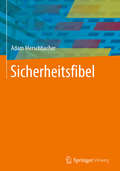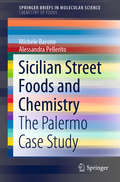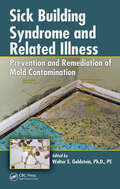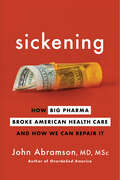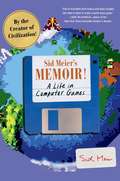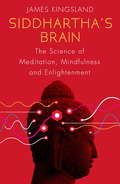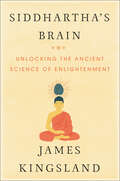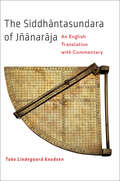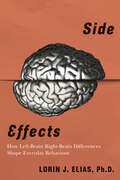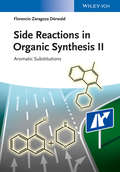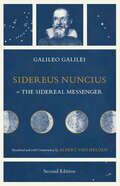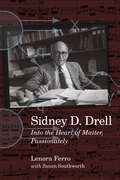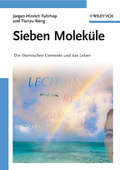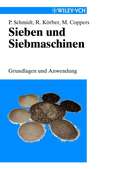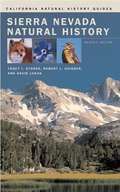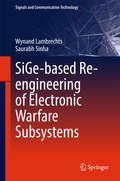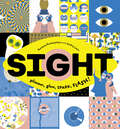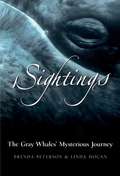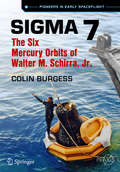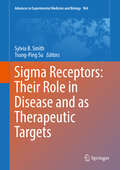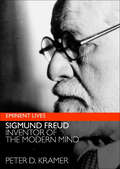- Table View
- List View
Sicherheitsfibel
by Adam MerschbacherDie „Sicherheitsfibel“ wird dem Fachmann für Sicherheitstechnik, dem interessierten Laien und den Beratern in Versicherungen, kriminalpolizeilichen Präventiveinrichtungen, sowie Herstellern in der Planung künftiger Sicherheitsprodukte einen fundierten Überblick über wirkungsvolle und sinnvolle Sicherungsmaßnahmen im privaten und gewerblichen Umfeld geben. Das Wort „Gewerbe“ soll, auch wenn es nicht immer passend ist, für Unternehmen, Ladengeschäfte, Banken, Kirchen, Behörden, Museen, ja sogar für Zirkus und Tierpark stehen. Dabei spielt die Größe überhaupt keine Rolle. Die Sicherungsrichtlinien gelten für die Würstelbude ebenso wie für größte Industrieunternehmen. Sicherheit wird grob in mechanische und elektronische Sicherungsmaßnahmen eingeteilt. Die Themen Brandschutz und IT-Sicherheit sind so komplex, dass nur sehr oberflächlich darauf eingegangen werden kann.
Sicherheitsfibel
by Adam MerschbacherDie „Sicherheitsfibel“ wird dem Fachmann für Sicherheitstechnik, dem interessierten Laien und den Beratern in Versicherungen, kriminalpolizeilichen Präventiveinrichtungen, sowie Herstellern in der Planung künftiger Sicherheitsprodukte einen fundierten Überblick über wirkungsvolle und sinnvolle Sicherungsmaßnahmen im privaten und gewerblichen Umfeld geben. Das Wort „Gewerbe“ soll, auch wenn es nicht immer passend ist, für Unternehmen, Ladengeschäfte, Banken, Kirchen, Behörden, Museen, ja sogar für Zirkus und Tierpark stehen. Dabei spielt die Größe überhaupt keine RolleSicherheit wird grob in mechanische und elektronische Sicherungsmaßnahmen eingeteilt. Die Themen Brandschutz und IT-Sicherheit sind so komplex, dass nur sehr oberflächlich darauf eingegangen werden kann.
Sicilian Street Foods and Chemistry: The Palermo Case Study (SpringerBriefs in Molecular Science)
by Michele Barone Alessandra PelleritoThis book reviews the authenticity of certain Street Food specialties from the viewpoint of food chemists. At present, the food market clearly shows the predominance of fast-food operators in many Western countries. However, the concomitant presence of the traditional lifestyle model known as the Mediterranean Diet in Europe has also been increasingly adopted in many countries, in some cases with unforeseen effects such as offering Mediterranean-like foods for out-of-home consumption. This commercial strategy also includes the so-called Street Food, which is marketed as a variation on Mediterranean foods. One of the best known versions of Street Food products can be found in Sicily, Italy, and particularly in its largest city, Palermo. Because of certain authenticity issues, the Italian National Council of Research Chemists has issued four procedural guidelines for various Palermo specialties with the aim of attaining the traditional specialty guaranteed status in accordance with European Regulation (EU) No 1151/2012. The first chapter of the book provides a brief introduction to the general concept of Street Foods. The remaining four chapters describe four food specialties – Arancina, Sfincionello, Pane ca meusa, and Pane e panelle – typically produced in Palermo, with particular reference to their chemical composition, identification of raw materials from a chemical viewpoint, permissible cooking and preparation procedures (with chemical explanations), preservation, and storage. The book offers a unique guide to Street Food authenticity, and can also serve as a reference work for other traditional/historical products.
Sick Building Syndrome and Related Illness: Prevention and Remediation of Mold Contamination
by Walter E. GoldsteinSmall but mighty, ranging from 3 to 100 microns in size, miniscule mold organisms can cause big problems. A seemingly minor water leak behind a wall, unnoticed until the sinister color of mold is evident, can wreak havoc and cause a financial nightmare. A practical primer, Sick Building Syndrome and Related Illness: Prevention and Remediation of Mo
Sickening: How Big Pharma Broke American Health Care and How We Can Repair It
by John AbramsonThe inside story of how Big Pharma&’s relentless pursuit of ever-higher profits corrupts medical knowledge—misleading doctors, misdirecting American health care, and harming our health. The United States spends an excess $1.5 trillion annually on health care compared to other wealthy countries—yet the amount of time that Americans live in good health ranks a lowly 68th in the world. At the heart of the problem is Big Pharma, which funds most clinical trials and therefore controls the research agenda, withholds the real data from those trials as corporate secrets, and shapes most of the information relied upon by health care professionals. In this no-holds-barred exposé, Dr. John Abramson—one of the foremost experts on the drug industry&’s deceptive tactics—combines patient stories with what he learned during many years of serving as an expert in national drug litigation to reveal the tangled web of financial interests at the heart of the dysfunction in our health-care system. For example, one of pharma&’s best-kept secrets is that the peer reviewers charged with ensuring the accuracy and completeness of the clinical trial reports published in medical journals do not even have access to complete data and must rely on manufacturer-influenced summaries. Likewise for the experts who write the clinical practice guidelines that define our standards of care. The result of years of research and privileged access to the inner workings of the U.S. medical-industrial complex, Sickening shines a light on the dark underbelly of American health care—and presents a path toward genuine reform.
Sid Meier's Memoir!: A Life In Computer Games
by Sid MeierThe life and career of the legendary developer celebrated as the “godfather of computer gaming,” and creator of Civilization. Over his four-decade career, Sid Meier has produced some of the world’s most popular video games, including Sid Meier’s Civilization, which has sold more than 51 million units worldwide and accumulated more than one billion hours of play. Sid Meier’s Memoir! is the story of an obsessive young computer enthusiast who helped launch a multibillion-dollar industry. Writing with warmth and ironic humor, Meier describes the genesis of his influential studio, MicroProse, founded in 1982 after a trip to a Las Vegas arcade, and recounts the development of landmark games, from vintage classics like Pirates! and Railroad Tycoon, to Civilization and beyond. Articulating his philosophy that a video game should be “a series of interesting decisions,” Meier also shares his perspective on the history of the industry, the psychology of gamers, and fascinating insights into the creative process, including his rules of good game design.
Siddhartha's Brain: The Science of Meditation, Mindfulness and Enlightenment
by James KingslandWINNER OF THE GOLD PRIZE FOR RELIGION / SPIRITUALITY OF EASTERN THOUGHT AT THE 2016 NAUTILUS BOOK AWARDS.Can meditation and mindfulness exercise make us sharper, smarter, healthier, happier? In Siddhartha's Brain, James Kingsland reveals that a complete scientific theory of how these practices work is now within our grasp and may be the key to treating a wide range of afflictions of the human mind. Some twenty-five centuries ago, an Indian sage called Siddhartha Gautama - the man who would become known as the Buddha - developed a programme for improving mental well-being which has been passed down to us by generations of monks and nuns. Today, secular mindfulness courses are proving their worth for tackling many of the problems associated with the demands of our frenetic, technology-driven modern world.Research has shown that mindfulness can be used to treat stress, anxiety, depression, chronic pain, hypertension and drug addiction, as well as improving concentration, empathy, emotion regulation and the quality of interpersonal relationships. There have even been hints that it could enhance immune function, slow cellular ageing and help keep dementia at bay. Taking us on a journey back to the time of the Buddha to track changes in his brain as he travels the path leading to enlightenment, Siddhartha's Brain explains how meditation and mindfulness transform the human mind.
Siddhartha's Brain: Unlocking the Ancient Science of Enlightenment
by James KingslandGuardian science editor James Kingsland unlocks the ancient science of enlightenment through the journey of Siddhartha—better known as Buddha.In a lush grove on the banks of the Neranjara in northern India—400 years before the birth of Christ, when the foundations of western science and philosophy were being laid by the great minds of Ancient Greece—a prince turned ascetic wanderer sat beneath a fig tree. His name was Siddhartha Gautama, and he was discovering the astonishing capabilities of the human brain and the secrets of mental wellness and spiritual “enlightenment”—the foundation of Buddhism.Framed by the historical journey and teachings of the Buddha, Siddhartha’s Brain shows how meditative and Buddhist practice anticipated the findings of modern neuroscience. Moving from the evolutionary history of the brain to the disorders and neuroses associated with our technology-driven world, James Kingsland explains why the ancient practice of mindfulness has been so beneficial and so important for human beings across time. Far from a New Age fad, the principles of meditation have deep scientific support and have been proven to be effective in combating many contemporary psychiatric disorders. Siddhartha posited that “Our life is shaped by our mind; we become what we think.” As we are increasingly driven to distraction by competing demands, our ability to focus and control our thoughts has never been more challenged—or more vital.Siddhartha’s Brain offers a cutting-edge, big-picture assessment of meditation and mindfulness: how it works, what it does to our brains, and why meditative practice has never been more important.
The Siddhāntasundara of Jñānarāja: An English Translation with Commentary
by Toke Lindegaard KnudsenThe first English translation of this major work of classical Indian astronomy and mathematics.A treasure for anyone interested in early modern India and the history of mathematics, this first English translation of the Siddhāntasundara reveals the fascinating work of the scholar-astronomer Jñānarāja (circa 1500 C.E.). Toke Lindegaard Knudsen begins with an introduction to the traditions of ancient Hindu astronomy and describes what is known of Jñānarāja’s life and family. He translates the Sanskrit verses into English and offers expert commentary on the style and substance of Jñānarāja's treatise.The Siddhāntasundara contains a comprehensive exposition of the system of Indian astronomy, including how to compute planetary positions and eclipses. It also explores deep, probing questions about the workings of the universe and sacred Hindu traditions. In a philosophical discussion, the treatise seeks a synthesis between the cosmological model used by the Indian astronomical tradition and the cosmology of a class of texts sacred in Hinduism. In his discourse, which includes a discussion of the direction of down and adhesive antipodeans, Jñānarāja rejects certain principles from the astronomical tradition and reinterprets principles from the sacred texts. He also constructs a complex poem on the seasons, many verses of which have two layers of meaning, one describing a season, the other a god's activities in that season. The Siddhāntasundara is the last major treatise of Indian astronomy and cosmology to receive serious scholarly attention, Knudsen’s careful effort unveils the 500-year-old Sanskrit verses and shows the clever quirkiness of Jñānarāja's writing style, his keen use of mathematics, and his subtle philosophical arguments.
Side Casts: A Collection of Fly-Fishing Yarns by a Guy Who Can Spin Them
by Hoagy B. CarmichaelThis beautiful, eclectic collection of first-person stories from bamboo rod-making legend Hoagy B. Carmichael explores various important parts of his life and how they tie into the sport of fishing. Growing up in Beverly Hills with a famous jazz musician for a father, young Hoagy wasn’t exactly destined to become a fisherman. But by the age of nine he had a subscription to Field and Stream magazine, and regularly rode his bicycle to the local “sport shop of the stars” in town. With strong and exciting prose, Carmichael takes readers through these early years and those that followed, where he not only honed his passion for fly fishing, but also his skills as a rod builder, fly fisherman, and author. In addition to reflecting on his life in fly fishing, Carmichael gives readers a fascinating look into the history of rod making and competitive fishing. He also describes encounters with some of the biggest names in the art of fine bamboo rod-making, such as Ed Fody and Everett Garrison. Side Casts is an artfully crafted and meticulously researched book that expertly weaves together elements of memoir, history, and sports writing. It will be a welcome addition to any fishing enthusiast’s bookshelf.
Side Effects: How Left-Brain Right-Brain Differences Shape Everyday Behaviour
by Lorin J. EliasUnderstanding how right-brain and left-brain differences influence our habits, thoughts, and actions.Human behaviour is lopsided. When cradling a newborn child, most of us cradle the infant to the left. When posing for a portrait, we tend to put our left cheek forward. When kissing a lover, we usually tilt our head to the right. Why is our behaviour so lopsided and what does this teach us about our brains? How have humans instinctively used this information to make our images more attractive and impactful? Can knowing how left-brain right-brain differences shape our opinions, tendencies, and attitudes help us make better choices in art, architecture, advertising, or even athletics? Side Effects delves into how lateral biases in our brains influence everyday behaviour and how being aware of these biases can be to our advantage.
Side Reactions in Organic Synthesis II
by Florencio Zaragoza DörwaldThis new textbook is the successor to the volume "Side Reactions in Organic Synthesis - A Guide to Successful Synthesis Design" (2004), written by the same author. Whereas the predecessor mainly covered the limitations of aliphatic substitution reactions, this new volume focuses on the most important aromatic substitution reactions, both electrophilic and nucleophilic, such as amination reactions, halogenation reactions, Friedel-Crafts acylations, or transition metal-catalyzed arylation reactions. Each chapter not only describes the scope of a specific reaction type, but also reveals what cannot be achieved with this reaction, i.e. what type of side reactions are to be expected with certain starting materials or electrophiles/nucleophiles. With its unique approach, this is a must-have book for graduate students in organic chemistry and synthetic chemists both in academia and industry!
Sidereus Nuncius, or The Sidereal Messenger (2nd Edition)
by Galileo Galilei Albert Van HeldenGalileo Galilei's Sidereus Nuncius is arguably the most dramatic scientific book ever published. It announced new and unexpected phenomena in the heavens, "unheard of through the ages," revealed by a mysterious new instrument. Galileo had ingeniously improved the rudimentary "spyglasses" that appeared in Europe in 1608, and in the autumn of 1609 he pointed his new instrument at the sky, revealing astonishing sights: mountains on the moon, fixed stars invisible to the naked eye, individual stars in the Milky Way, and four moons around the planet Jupiter. These discoveries changed the terms of the debate between geocentric and heliocentric cosmology and helped ensure the eventual acceptance of the Copernican planetary system. Albert Van Helden's beautifully rendered and eminently readable translation is based on the Venice 1610 edition's original Latin text. An introduction, conclusion, and copious notes place the book in its historical and intellectual context, and a new preface, written by Van Helden, highlights recent discoveries in the field, including the detection of a forged copy of Sidereus Nuncius, and new understandings about the political complexities of Galileo's work.
Sidney D. Drell: Into the Heart of Matter, Passionately
by Lenora FerroSidney Drell (1926–2016) left a legacy worthy of many lifetimes. Physicist, professor, national security expert, amateur musician, behind-the-scenes diplomat, and champion for peace and human rights, he was also friend and mentor. Dozens of interviews with those whose lives he touched reveal Drell as a man of brilliance, curiosity, and passions, whose devotion to the arts, family, and community equaled his love for physics. Teaching at Stanford University and working at its linear particle accelerator, Drell made significant scientific contributions. Not content to leave science in the lab or classroom, Drell brought his intellectual heft to public service, advising the US government on issues relating to science, advocating for Russian dissident Andrei Sakharov, and urging nuclear disarmament. Scaling the heights of achievement with a down-to-earth sensibility, Drell met his destiny empowered and validated by a prodigious mind, generous spirit, and tact in fostering goodwill for the benefit of all.
Sieben Moleküle: Die chemischen Elemente und das Leben
by Jürgen-Hinrich Fuhrhop Tianyu WangEs ist Allgemeinwissen: der Mensch besteht zu mehr als 70 Gewichtsprozent aus Wasser - Man erfahrt dies entweder in der Natur auf Waldlehrpfaden oder in der Grundschule... Wasser ist uberlebenswichtig und wird in einem weit verzweigten Rohleitungssystem befordert: den Blut- und Lymphebahnen, vom kleinen Zeh bis in das Sprachzentrum des Hirns. Aber welche Rolle spielt Wasser in der Chemie des Menschen? Der Chemie-Professor Jurgen Fuhrhop und Dr. Tianyu Wang haben die unubersehbare Anzahl chemischer Verbindung auf sieben Lebensmolekule beschrankt. Nach ihrer Auffassung sind diese, von der Evolution auserwahlten Molekule die Trager des menschlichen Lebens. Und die Autoren scheuen weder einen Blick ins Universum, wo die chemischen Elemente herkommen, noch auf die Verfahrenstechnik der Papierherstellung oder des Laserdruckers, die die Glucose nutzen. Menschen ab 15 ihre eigene Chemie anschaulich zu vermitteln, das ist das Ziel. Im Buch werden sowohl funktionierende ("gesunde") wie verstopfte ("kranke") Wasserlaufe dargestellt. Das Kohlenhydrat Glucose bildet Pflanzen und treibt die Hirne an, Lecithinmembranen umhullen biologische Zellen und bauen Stromquellen der Nerven und Muskeln auf. Tyrosin ist der wichtigste molekulare Anker fur Proteine und Arzneimittel, ohne ATP gabe es keinen Gedanken, kein Gefuhl, kein Erlebnis. Oxyham stellt den Sauerstoff der Luft atomar zur Verfugung damit Nahrungstoffe bei 37? C in Wasser verbrennen, Retinal leitet das Licht ins Gehirn und verwandelt es in Strom. Zur Vertiefung des Stoffes werden in jedem Kapitel Fragen gestellt. Die Antworten dazu findet man am Ende des Buches.
Sieben und Siebmaschinen: Grundlagen Und Anwendung
by Matthias Coppers Rolf Körber Paul SchmidtNach der Gewinnung bzw. Erzeugung von mineralischen, synthetischen oder organischen Roh- und Zwischenprodukten liegt in den meisten Fällen ein Schüttgut mit Körnern unterschiedlicher Größe und Form vor. <P><P>Für das Endprodukt wird durch Klassieren eine geforderte Korngrößenverteilung erreicht. Das einfachste mechanische Verfahren ist hier das Sieben. Auf der Grundlage aktueller Forschungs- und Entwicklungsarbeiten sowie Konstruktions- und Betriebserfahrungen werden im vorliegenden Buch ausführlich die Grundlagen der Siebtechnik und deren verfahrenstechnische Anwendung bei Siebmaschinen und Siebanalysegeräten behandelt. Ingenieure und Verfahrenstechniker vieler Industriezweige, u.a. Chemie, Metall, Pharmazie, Farben, Kohle, Erz, Zement, Kalk, Gips, Dünge-, Nahrungs- und Futtermittel, finden in diesem Handbuch Anleitung und Unterstützung bei der Lösung ihrer 'Siebprobleme' und können sich über den neusten Entwicklungstand der Siebtechnik informieren.
Sierra Nevada Natural History (California Natural History Guide #73)
by Tracy I. Storer Tom Taylor Robert L. Usinger David Lukas Phyllis M. Faber Peter Gaede John Gamel Bill Nelson Bruce M. Pavlik Christopher Rogers<p>The magnificent and much-loved Sierra Nevada, called the "Range of Light" by John Muir, is the dominant feature on the California landscape. First published forty years ago, this handbook has become an enduring natural history classic, used by thousands to learn more about virtually every aspect of this spectacular mountain range―from its superb flora and fauna to its rugged topography. <p>Comprehensive yet concise and portable, the book describes hundreds of species: trees and shrubs, flowering plants and ferns, fungi and lichens, insects and fish, amphibians and reptiles, and birds and mammals. Now completely updated and revised, it will continue to be the essential guide to the Sierra Nevada for a new generation of hikers, campers, tourists, naturalists, students, and teachers―everyone who wants to know more about this unique and beautiful mountain range. </p>
Sífilis: otra enfermedad que nos llegó de Europa la medicina y la sífilis en el Viejo Mundo
by Naranjo PlutarcoEntre marzo y abril de 1495, en Nápoles, se desató una terrible epidemia de sífilis que luego se propagó a Francia y desde aquí al resto de Europa. Durante los primeros cuarenta años de la epidemia nadie puso en duda el sitio dónde se originó y luego cuál país se convirtió en el foco de diseminación del mal venéreo que comenzó a llamarse el morbo gálico. Inesperadamente ciertos autores poco escrupulosos, del siglo XVI, afirmaron que la sífilis era originaria de América, continente al cual, sin quererlo, Europa había "exportado" todas las pestes del Viejo Mundo. Existe un dicho popular: "favor con favor se paga", parafraseándolo en sentido inverso, parecería que se trataba de demostrar que hubo un intercambio epidémico y que en "reciprocidad" de las enfermedades que Europa envió a América, ésta exportó al Viejo Continente la sífilis.
SiGe-based Re-engineering of Electronic Warfare Subsystems
by Wynand Lambrechts Saurabh SinhaThis book provides readers a thorough understanding of the applicability of new-generation silicon-germanium (SiGe) electronic subsystems for electronic warfare and defensive countermeasures in military contexts. It explains in detail the theoretical and technical background, and addresses all aspects of the integration of SiGe as an enabling technology for maritime, land, and airborne / spaceborne electronic warfare, including research, design, development, and implementation. The coverage is supported by mathematical derivations, informative illustrations, practical examples, and case studies. While SiGe technology provides speed, performance, and price advantages in many markets, to date only limited information has been available on its use in electronic warfare systems, especially in developing nations. Addressing that need, this book offers essential engineering guidelines that especially focus on the speed and reliability of current-generation SiGe circuits and highlight emerging innovations that help to ensure the sustainable long-term integration of SiGe into electronic warfare systems.
Sight: Glimmer, Glow, SPARK, FLASH!
by Romana Romanyshyn Andriy LesivSight is a groundbreaking introduction to our vivid, sensory world.This nonfiction book is an immediately accessible, science-intensive illumination of an endlessly fascinating subject: sight.Packed with facts about all aspects of vision, this is a sensitive exploration of how sight essentially impacts our everyday lives.• At once instructional and inspirational• Features stunning visual sophistication• Filled with compelling infographicsSight is a stunning, multifaceted visual exploration of one of our critical senses.This gorgeous book goes beyond the facts—it encourages not only scientific exploration, but philosophical reflection on the very nature of vision. • Resonates year-round as a go-to gift for birthdays, holidays, and more• Perfect for curious children ages 8 to 12 years old• Equal parts educational and visual, this makes a great pick for schools, librarians, teachers, grandparents, and parents.• You'll love this book if you love books like Nature Anatomy: The Curious Parts and Pieces of the Natural by Julia Rothman, Animalium: Welcome to the Museum by Jenny Broom, and Eye to Eye: How Animals See the World by Steve Jenkins.
Sightings: The Gray Whales' Mysterious Journey
by Linda Hogan Brenda PetersonTraces the lives of gray whales during their migrations between Alaska and Mexico, from their summer feeding grounds in the Bering Sea to winter birthing lagoons in Baja, examining their rich history including the conflict between their hunters and environmental protectors.
Sigma 7
by Colin BurgessColin Burgess offers a comprehensive yet personal look at the 1962 orbital mission of Wally Schirra aboard the spacecraft Sigma 7, the first book about this popular pioneering astronaut which explores his entire life and accomplishments. This continues the Pioneers in Early Spaceflight series, the volumes of which form an excellent record of Project Mercury's pioneering early phase of the Space Age. Schirra's pre-NASA life is examined, as well as his training as a NASA astronaut and for his Mercury MA-8 flight. The 6-orbit flight of Sigma 7 is fully covered from its origins through to the spacecraft's safe recovery from the ocean after a highly successful Mercury mission. Schirra's participation on the Gemini 6 and Apollo 7 missions is also told, but in brief, and the book also relates his post-NASA life and activities through to his passing in 2007. The Mercury Seven occupy a unique spot in the history of human spaceflight, and Schirra is at last given his due as one of the contributing astronauts in this painstakingly researched book.
Sigma Receptors: Their Role in Disease and as Therapeutic Targets
by Sylvia B. Smith Tsung-Ping SuOriginally confused with opioid receptors and then orphan receptors with no biological function, Sigma Receptors are now recognized as relevant to many degenerative diseases with remarkable potential as therapeutic targets. In this text, new information about the structure of sigma 1 receptor, its binding sites are provided as well as its expression in many cell types. It’s putative role in degenerative neuronal diseases including amyotrophic lateral sclerosis, Alzheimer’s disease, Parkinson’s disease, Huntington’s disease, pain, drug addiction and locomotor activity. Their roles in possible treatments for blinding retinal diseases emphasize the tremendous far-reaching potential for ligands for these receptors. Exciting breakthroughs in this dynamic field in the last decade are reported herein, which will guide future investigators in determining the full potential of this unique, yet abundantly expressed protein.
Sigmund Freud: Inventor of the Modern Mind (Eminent Lives)
by Peter D. KramerReferred to as "the father of psychoanalysis," Sigmund Freud is credited with championing the "talking cure" and charting the human unconscious. Both revered and reviled, he was a brilliant innovator but also a man of troubling contradictions—sometimes tyrannical, often misrepresenting the course and outcome of his treatments to make the "facts" match his theories. Peter D. Kramer—acclaimed author, practicing psychiatrist, and a leading national authority on mental health—offers a stunning new take on this controversial figure. Kramer is at once critical and sympathetic, presenting Freud the mythmaker, the storyteller, the writer whose books will survive among the classics of our literature, and the genius who transformed the way we see ourselves.
